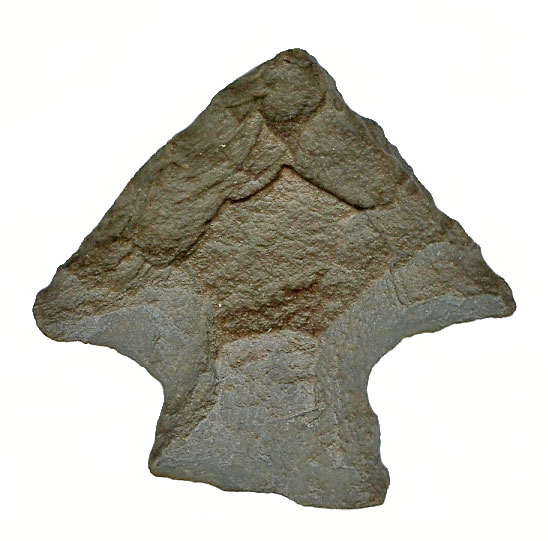

Point Type: PERKIOMEN
Also See: Ashtabula , Frost Island, Lehigh
Valley Broad, Mansion Inn, Susquehanna Broad
, Waratan
Location: Northeastern United States
Associated Dates: 4000 - 2500 B.P. - Late Archaic
- Early Woodland
Morphology: Stemmed
General Description: The Perkiomen point
is a broad medium-sized point which has a triangular blade with broadly rounded
to angular shoulders and a short expanded stem. Stem edges are ground. The basal edge is straight to slightly
convex. The overall shape of the point is very often asymmetrical due to an uneven resharpening
process. Exhausted
points often acquire the drill
form.
The
flaking is very bold using percussion flaking resulting in
semi-lozenge shaped scars.
The Perkiomen is found in New Jersey, New
York, Pennsylvania and parts of
adjacent states.
The size range for
the Perkiomen point is 50 mm to 228 mm range with typical average
length being between 55 mm and 76 mm. Average thickness ranges from 6
mm to 8 mm.
Perino states: " The Perkiomen
points are of the same age and culture
as the Susquehanna Broad points and are found in the same areas,
indicating a relationship. Needle tips are more common to new points
but may result from the resharpening process. Scrapers
are sometimes made from the broken
points."
Leslie states: " the Perkiomen is very rare in the Susquehanna
River Valley and may be related to the Lehigh Broad Spear type."
In Pennsylvania, the preferred lithic materials were
jasper, dark rhyolite, Onondaga gray and black flints or cherts, Deepkill and
Normanskill flints and rarely argillite or quartzite.
The Perkiomen point was named
by John Witthoft in 1953.
About the Point Above: The point
pictured above is a very small sized somewhat
symmetrical Perkiomen point
made from a dark black flint which may be Onondaga in origin.
The flint has a satiny and grainy patina and the point is very crudely made. I suspect this point to
be expended and at the end of its life. The blade edges are highly worn and rounded as if it were used as
a scraper. The base has been ground as have the edges of the
stem. The point measures 29 mm in length, 32 mm at the
widest point and is 6.5 mm thick at its thickest point (at the connection of the
stem and blade) with the typical thickness along the blade being 6 mm. This point
was found along the shores of the Housatonic river in Milford , CT
near the Baldwin Station site. I wonder how this Onondaga flint came to
reside here in Milford? There must have been some trading going on
with the eastern part of New York? Catalog Number 379-32-SS
References: Boudreau, Fogelman, Hranicky(1), Justice (1), Kinsey, Leslie, Overstreet, Perino (1), Ritchie, Waldorf
© Copyright 1997 - 2009 LITHICS-Net WWW.LITHICSNET.COM
Use your Browser's BACK Button to return to the LITHICS-Net Index.